SBM3202: Leadership and Governance Essay - Ethical Considerations
VerifiedAdded on 2023/05/28
|11
|2947
|221
Essay
AI Summary
This essay examines the critical aspects of leadership and governance, emphasizing the ethical responsibilities of CEOs and their impact on organizational success. It analyzes a case study, exploring the consequences of unethical behavior, such as fraudulent activities, and the importance of CEO accountability. The essay delves into leadership theories, the roles of the board of directors and stakeholders, and the importance of leading by example. It highlights the significance of a strong organizational culture, employee loyalty, and the need for CEOs to foster teamwork, diversity, and ethical practices. The essay emphasizes the need for CEOs to be visionary, decision-makers, and communicators, ultimately guiding their organizations towards success in a volatile business environment and ensuring transparency and accountability.
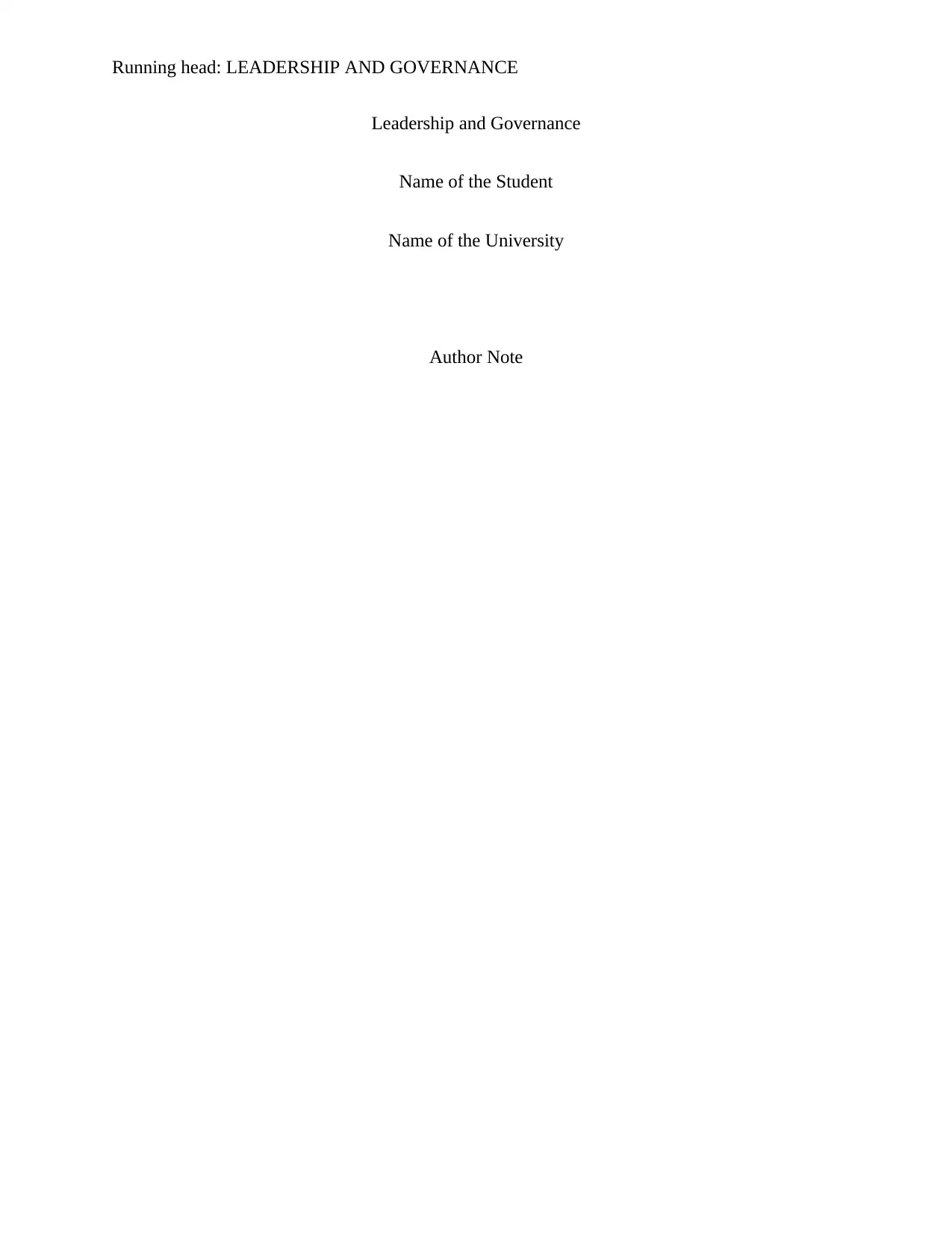
Running head: LEADERSHIP AND GOVERNANCE
Leadership and Governance
Name of the Student
Name of the University
Author Note
Leadership and Governance
Name of the Student
Name of the University
Author Note
Paraphrase This Document
Need a fresh take? Get an instant paraphrase of this document with our AI Paraphraser
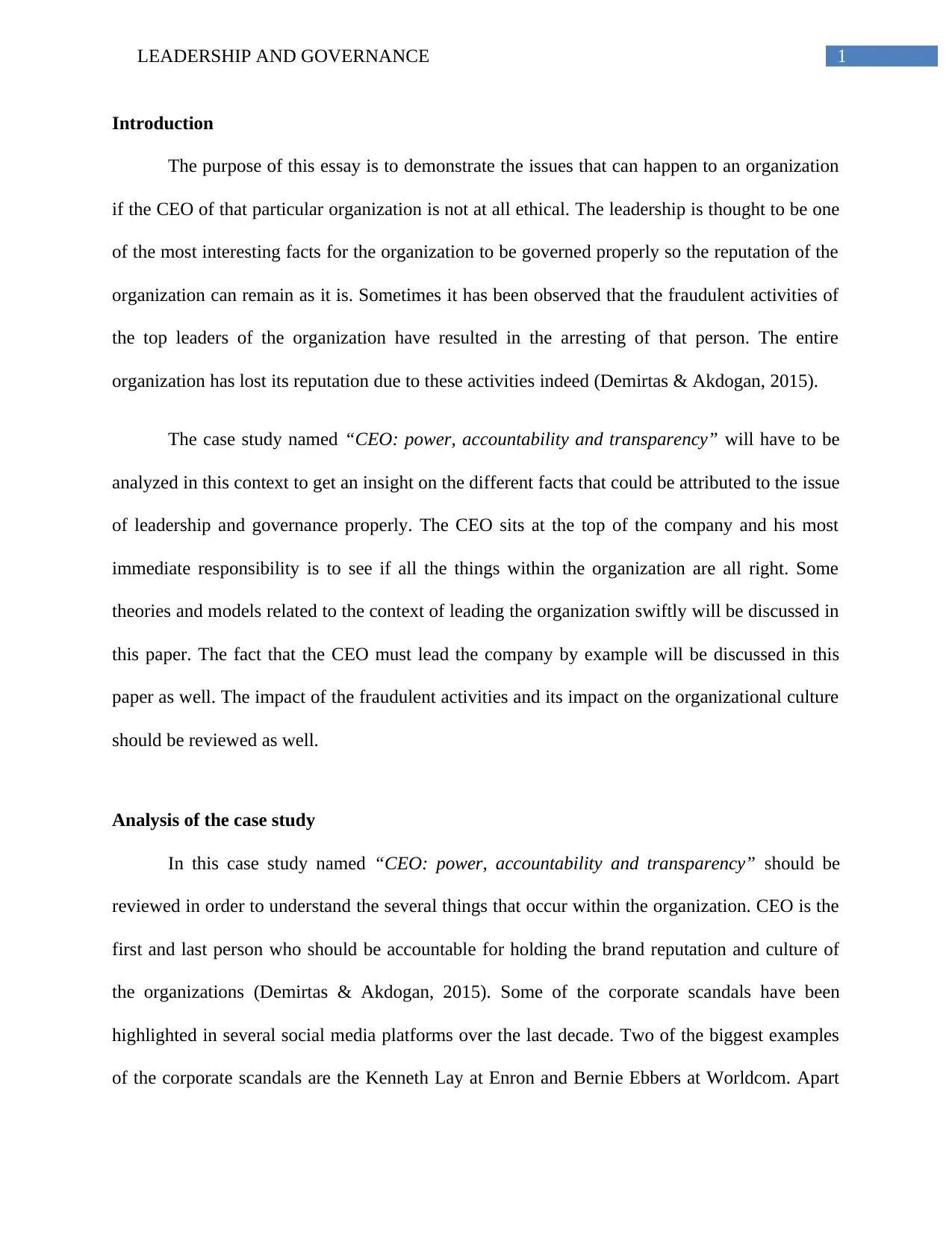
1LEADERSHIP AND GOVERNANCE
Introduction
The purpose of this essay is to demonstrate the issues that can happen to an organization
if the CEO of that particular organization is not at all ethical. The leadership is thought to be one
of the most interesting facts for the organization to be governed properly so the reputation of the
organization can remain as it is. Sometimes it has been observed that the fraudulent activities of
the top leaders of the organization have resulted in the arresting of that person. The entire
organization has lost its reputation due to these activities indeed (Demirtas & Akdogan, 2015).
The case study named “CEO: power, accountability and transparency” will have to be
analyzed in this context to get an insight on the different facts that could be attributed to the issue
of leadership and governance properly. The CEO sits at the top of the company and his most
immediate responsibility is to see if all the things within the organization are all right. Some
theories and models related to the context of leading the organization swiftly will be discussed in
this paper. The fact that the CEO must lead the company by example will be discussed in this
paper as well. The impact of the fraudulent activities and its impact on the organizational culture
should be reviewed as well.
Analysis of the case study
In this case study named “CEO: power, accountability and transparency” should be
reviewed in order to understand the several things that occur within the organization. CEO is the
first and last person who should be accountable for holding the brand reputation and culture of
the organizations (Demirtas & Akdogan, 2015). Some of the corporate scandals have been
highlighted in several social media platforms over the last decade. Two of the biggest examples
of the corporate scandals are the Kenneth Lay at Enron and Bernie Ebbers at Worldcom. Apart
Introduction
The purpose of this essay is to demonstrate the issues that can happen to an organization
if the CEO of that particular organization is not at all ethical. The leadership is thought to be one
of the most interesting facts for the organization to be governed properly so the reputation of the
organization can remain as it is. Sometimes it has been observed that the fraudulent activities of
the top leaders of the organization have resulted in the arresting of that person. The entire
organization has lost its reputation due to these activities indeed (Demirtas & Akdogan, 2015).
The case study named “CEO: power, accountability and transparency” will have to be
analyzed in this context to get an insight on the different facts that could be attributed to the issue
of leadership and governance properly. The CEO sits at the top of the company and his most
immediate responsibility is to see if all the things within the organization are all right. Some
theories and models related to the context of leading the organization swiftly will be discussed in
this paper. The fact that the CEO must lead the company by example will be discussed in this
paper as well. The impact of the fraudulent activities and its impact on the organizational culture
should be reviewed as well.
Analysis of the case study
In this case study named “CEO: power, accountability and transparency” should be
reviewed in order to understand the several things that occur within the organization. CEO is the
first and last person who should be accountable for holding the brand reputation and culture of
the organizations (Demirtas & Akdogan, 2015). Some of the corporate scandals have been
highlighted in several social media platforms over the last decade. Two of the biggest examples
of the corporate scandals are the Kenneth Lay at Enron and Bernie Ebbers at Worldcom. Apart
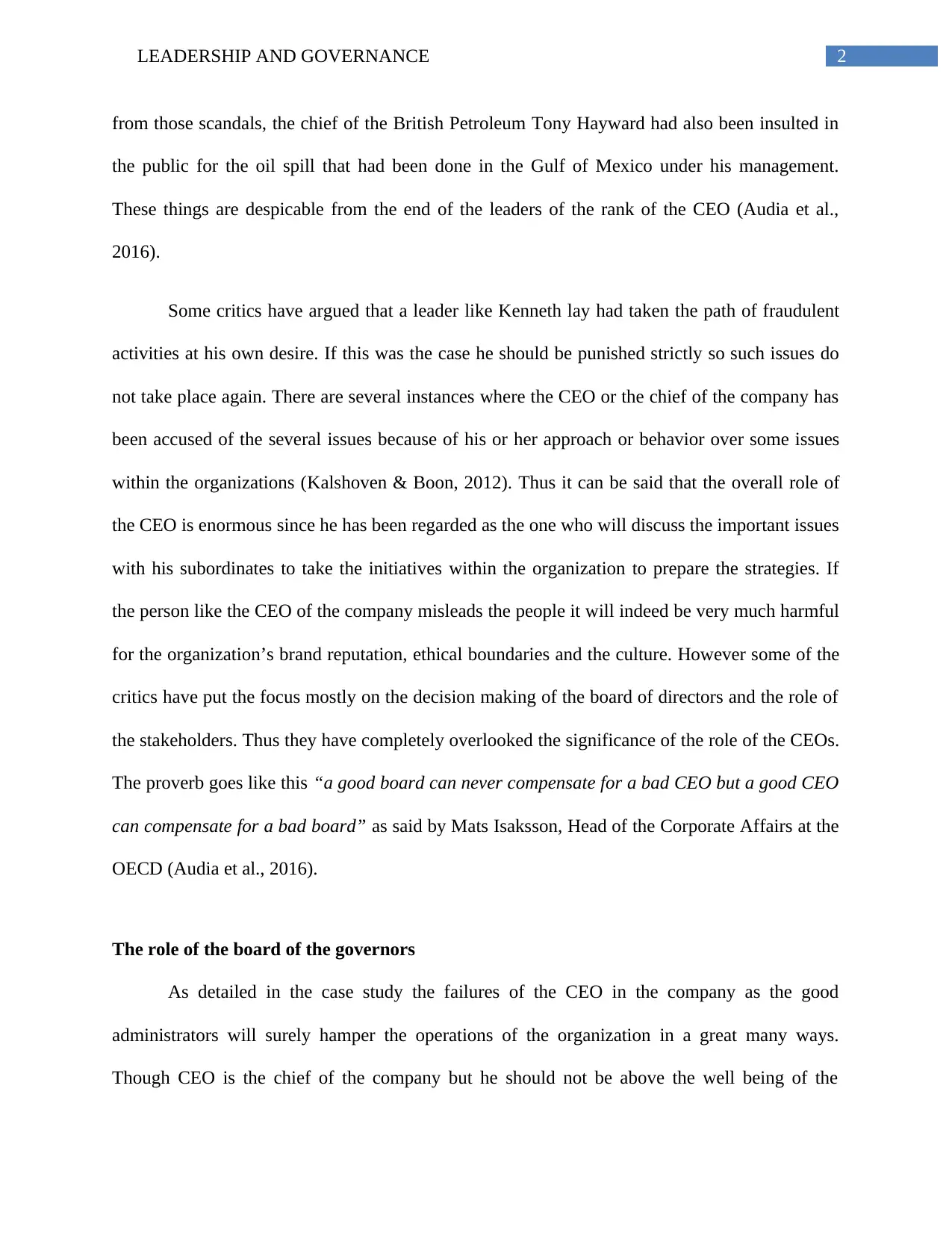
2LEADERSHIP AND GOVERNANCE
from those scandals, the chief of the British Petroleum Tony Hayward had also been insulted in
the public for the oil spill that had been done in the Gulf of Mexico under his management.
These things are despicable from the end of the leaders of the rank of the CEO (Audia et al.,
2016).
Some critics have argued that a leader like Kenneth lay had taken the path of fraudulent
activities at his own desire. If this was the case he should be punished strictly so such issues do
not take place again. There are several instances where the CEO or the chief of the company has
been accused of the several issues because of his or her approach or behavior over some issues
within the organizations (Kalshoven & Boon, 2012). Thus it can be said that the overall role of
the CEO is enormous since he has been regarded as the one who will discuss the important issues
with his subordinates to take the initiatives within the organization to prepare the strategies. If
the person like the CEO of the company misleads the people it will indeed be very much harmful
for the organization’s brand reputation, ethical boundaries and the culture. However some of the
critics have put the focus mostly on the decision making of the board of directors and the role of
the stakeholders. Thus they have completely overlooked the significance of the role of the CEOs.
The proverb goes like this “a good board can never compensate for a bad CEO but a good CEO
can compensate for a bad board” as said by Mats Isaksson, Head of the Corporate Affairs at the
OECD (Audia et al., 2016).
The role of the board of the governors
As detailed in the case study the failures of the CEO in the company as the good
administrators will surely hamper the operations of the organization in a great many ways.
Though CEO is the chief of the company but he should not be above the well being of the
from those scandals, the chief of the British Petroleum Tony Hayward had also been insulted in
the public for the oil spill that had been done in the Gulf of Mexico under his management.
These things are despicable from the end of the leaders of the rank of the CEO (Audia et al.,
2016).
Some critics have argued that a leader like Kenneth lay had taken the path of fraudulent
activities at his own desire. If this was the case he should be punished strictly so such issues do
not take place again. There are several instances where the CEO or the chief of the company has
been accused of the several issues because of his or her approach or behavior over some issues
within the organizations (Kalshoven & Boon, 2012). Thus it can be said that the overall role of
the CEO is enormous since he has been regarded as the one who will discuss the important issues
with his subordinates to take the initiatives within the organization to prepare the strategies. If
the person like the CEO of the company misleads the people it will indeed be very much harmful
for the organization’s brand reputation, ethical boundaries and the culture. However some of the
critics have put the focus mostly on the decision making of the board of directors and the role of
the stakeholders. Thus they have completely overlooked the significance of the role of the CEOs.
The proverb goes like this “a good board can never compensate for a bad CEO but a good CEO
can compensate for a bad board” as said by Mats Isaksson, Head of the Corporate Affairs at the
OECD (Audia et al., 2016).
The role of the board of the governors
As detailed in the case study the failures of the CEO in the company as the good
administrators will surely hamper the operations of the organization in a great many ways.
Though CEO is the chief of the company but he should not be above the well being of the
⊘ This is a preview!⊘
Do you want full access?
Subscribe today to unlock all pages.

Trusted by 1+ million students worldwide
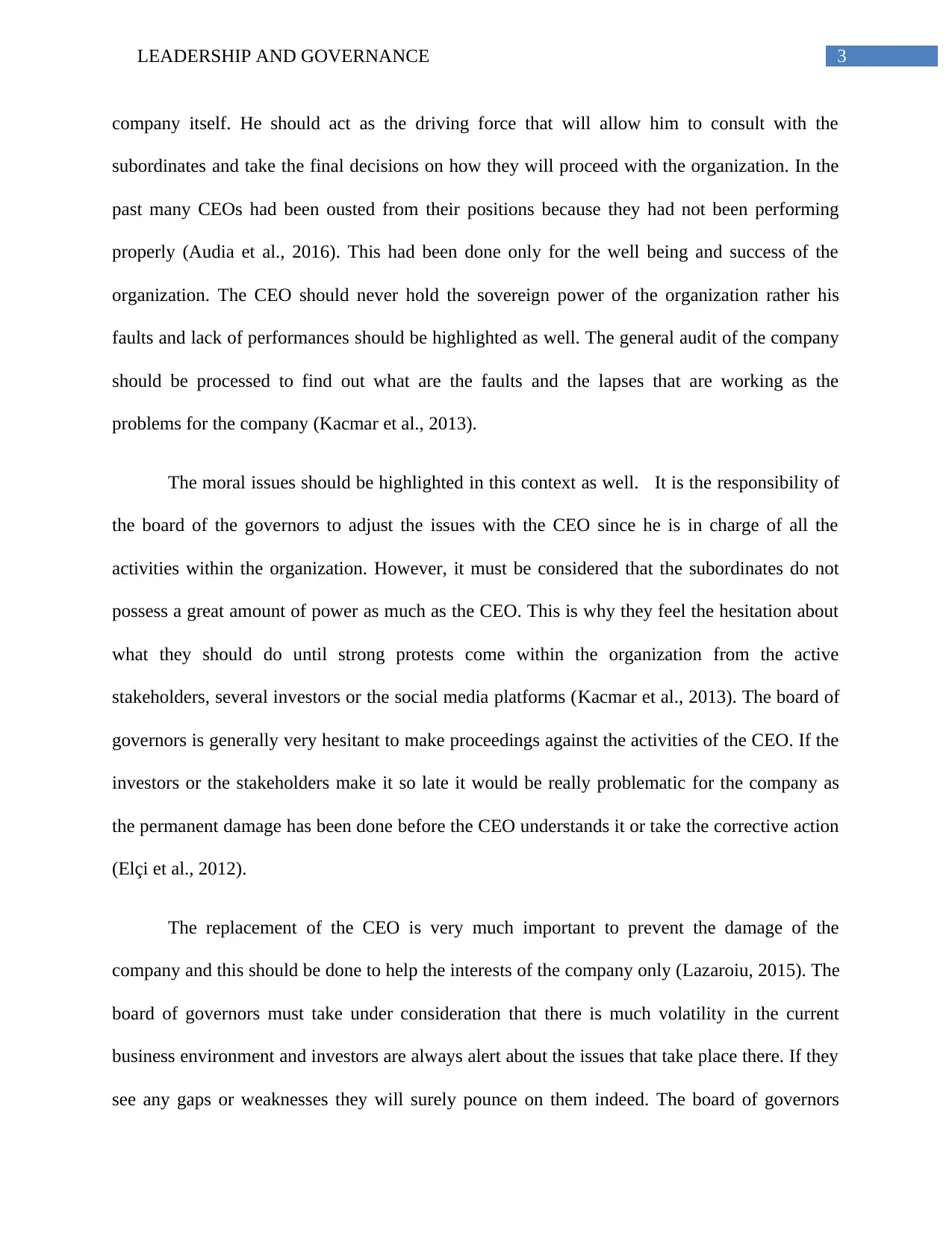
3LEADERSHIP AND GOVERNANCE
company itself. He should act as the driving force that will allow him to consult with the
subordinates and take the final decisions on how they will proceed with the organization. In the
past many CEOs had been ousted from their positions because they had not been performing
properly (Audia et al., 2016). This had been done only for the well being and success of the
organization. The CEO should never hold the sovereign power of the organization rather his
faults and lack of performances should be highlighted as well. The general audit of the company
should be processed to find out what are the faults and the lapses that are working as the
problems for the company (Kacmar et al., 2013).
The moral issues should be highlighted in this context as well. It is the responsibility of
the board of the governors to adjust the issues with the CEO since he is in charge of all the
activities within the organization. However, it must be considered that the subordinates do not
possess a great amount of power as much as the CEO. This is why they feel the hesitation about
what they should do until strong protests come within the organization from the active
stakeholders, several investors or the social media platforms (Kacmar et al., 2013). The board of
governors is generally very hesitant to make proceedings against the activities of the CEO. If the
investors or the stakeholders make it so late it would be really problematic for the company as
the permanent damage has been done before the CEO understands it or take the corrective action
(Elçi et al., 2012).
The replacement of the CEO is very much important to prevent the damage of the
company and this should be done to help the interests of the company only (Lazaroiu, 2015). The
board of governors must take under consideration that there is much volatility in the current
business environment and investors are always alert about the issues that take place there. If they
see any gaps or weaknesses they will surely pounce on them indeed. The board of governors
company itself. He should act as the driving force that will allow him to consult with the
subordinates and take the final decisions on how they will proceed with the organization. In the
past many CEOs had been ousted from their positions because they had not been performing
properly (Audia et al., 2016). This had been done only for the well being and success of the
organization. The CEO should never hold the sovereign power of the organization rather his
faults and lack of performances should be highlighted as well. The general audit of the company
should be processed to find out what are the faults and the lapses that are working as the
problems for the company (Kacmar et al., 2013).
The moral issues should be highlighted in this context as well. It is the responsibility of
the board of the governors to adjust the issues with the CEO since he is in charge of all the
activities within the organization. However, it must be considered that the subordinates do not
possess a great amount of power as much as the CEO. This is why they feel the hesitation about
what they should do until strong protests come within the organization from the active
stakeholders, several investors or the social media platforms (Kacmar et al., 2013). The board of
governors is generally very hesitant to make proceedings against the activities of the CEO. If the
investors or the stakeholders make it so late it would be really problematic for the company as
the permanent damage has been done before the CEO understands it or take the corrective action
(Elçi et al., 2012).
The replacement of the CEO is very much important to prevent the damage of the
company and this should be done to help the interests of the company only (Lazaroiu, 2015). The
board of governors must take under consideration that there is much volatility in the current
business environment and investors are always alert about the issues that take place there. If they
see any gaps or weaknesses they will surely pounce on them indeed. The board of governors
Paraphrase This Document
Need a fresh take? Get an instant paraphrase of this document with our AI Paraphraser
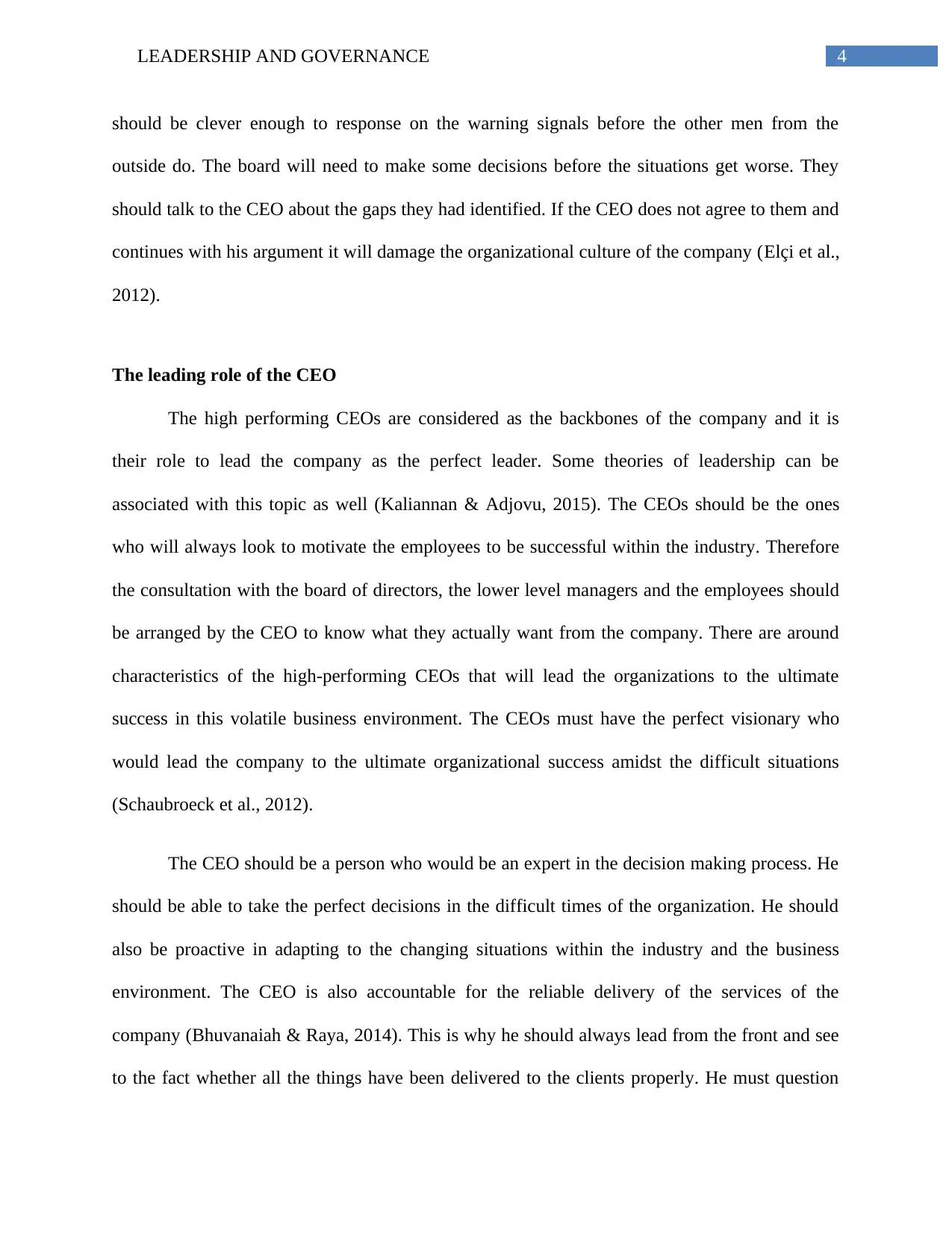
4LEADERSHIP AND GOVERNANCE
should be clever enough to response on the warning signals before the other men from the
outside do. The board will need to make some decisions before the situations get worse. They
should talk to the CEO about the gaps they had identified. If the CEO does not agree to them and
continues with his argument it will damage the organizational culture of the company (Elçi et al.,
2012).
The leading role of the CEO
The high performing CEOs are considered as the backbones of the company and it is
their role to lead the company as the perfect leader. Some theories of leadership can be
associated with this topic as well (Kaliannan & Adjovu, 2015). The CEOs should be the ones
who will always look to motivate the employees to be successful within the industry. Therefore
the consultation with the board of directors, the lower level managers and the employees should
be arranged by the CEO to know what they actually want from the company. There are around
characteristics of the high-performing CEOs that will lead the organizations to the ultimate
success in this volatile business environment. The CEOs must have the perfect visionary who
would lead the company to the ultimate organizational success amidst the difficult situations
(Schaubroeck et al., 2012).
The CEO should be a person who would be an expert in the decision making process. He
should be able to take the perfect decisions in the difficult times of the organization. He should
also be proactive in adapting to the changing situations within the industry and the business
environment. The CEO is also accountable for the reliable delivery of the services of the
company (Bhuvanaiah & Raya, 2014). This is why he should always lead from the front and see
to the fact whether all the things have been delivered to the clients properly. He must question
should be clever enough to response on the warning signals before the other men from the
outside do. The board will need to make some decisions before the situations get worse. They
should talk to the CEO about the gaps they had identified. If the CEO does not agree to them and
continues with his argument it will damage the organizational culture of the company (Elçi et al.,
2012).
The leading role of the CEO
The high performing CEOs are considered as the backbones of the company and it is
their role to lead the company as the perfect leader. Some theories of leadership can be
associated with this topic as well (Kaliannan & Adjovu, 2015). The CEOs should be the ones
who will always look to motivate the employees to be successful within the industry. Therefore
the consultation with the board of directors, the lower level managers and the employees should
be arranged by the CEO to know what they actually want from the company. There are around
characteristics of the high-performing CEOs that will lead the organizations to the ultimate
success in this volatile business environment. The CEOs must have the perfect visionary who
would lead the company to the ultimate organizational success amidst the difficult situations
(Schaubroeck et al., 2012).
The CEO should be a person who would be an expert in the decision making process. He
should be able to take the perfect decisions in the difficult times of the organization. He should
also be proactive in adapting to the changing situations within the industry and the business
environment. The CEO is also accountable for the reliable delivery of the services of the
company (Bhuvanaiah & Raya, 2014). This is why he should always lead from the front and see
to the fact whether all the things have been delivered to the clients properly. He must question

5LEADERSHIP AND GOVERNANCE
the employees if he finds if he finds anything missing from the list (Schaubroeck et al., 2012).
His leading role must be effective and it should have an impact on the approach and behaviors of
the employees. The employees must have respect for the CEO since he would guide the
employees towards their professional success as well. It is not the fact that all the CEOs should
be the successful leaders for the companies. Apart from the technical things, the CEO must also
express (Shin, 2012).
The CEOs should control the business operations with the proper corporate governance.
The CEOs will definitely be accountable to the investors of the organization (Benn, Edwards &
Williams, 2014). According to some of the critics, the global business environment is very
quickly changing and everyone must be able to adapt to the new situations and share the most
appropriate information (Yidong & Xinxin, 2013). The CEO should always lead the company by
sharing the most relevant information to the several shareholders. The CEO should have a clear
vision about where he wants to take the company. In order to soar to the new heights of success,
the CEO must be accountable to the employees as well. If his messages are clear to the
employees they will cater to the growth of the organization in the best ways they can. The CEO
should lead the company by seeking the best efforts from the stakeholders associated with the
company. The ethical values and behaviors will be very important for the CEO to indulge in the
best practices (Shin, 2012).
Leveraging the loyalty of the employees
The CEO will also have to take the pioneering role in building the teamwork for the
employees (Alvesson & Sveningsson, 2015). The organizational culture should be designed in
such a way by the CEO so that the employees from all sorts of cultural backgrounds and
the employees if he finds if he finds anything missing from the list (Schaubroeck et al., 2012).
His leading role must be effective and it should have an impact on the approach and behaviors of
the employees. The employees must have respect for the CEO since he would guide the
employees towards their professional success as well. It is not the fact that all the CEOs should
be the successful leaders for the companies. Apart from the technical things, the CEO must also
express (Shin, 2012).
The CEOs should control the business operations with the proper corporate governance.
The CEOs will definitely be accountable to the investors of the organization (Benn, Edwards &
Williams, 2014). According to some of the critics, the global business environment is very
quickly changing and everyone must be able to adapt to the new situations and share the most
appropriate information (Yidong & Xinxin, 2013). The CEO should always lead the company by
sharing the most relevant information to the several shareholders. The CEO should have a clear
vision about where he wants to take the company. In order to soar to the new heights of success,
the CEO must be accountable to the employees as well. If his messages are clear to the
employees they will cater to the growth of the organization in the best ways they can. The CEO
should lead the company by seeking the best efforts from the stakeholders associated with the
company. The ethical values and behaviors will be very important for the CEO to indulge in the
best practices (Shin, 2012).
Leveraging the loyalty of the employees
The CEO will also have to take the pioneering role in building the teamwork for the
employees (Alvesson & Sveningsson, 2015). The organizational culture should be designed in
such a way by the CEO so that the employees from all sorts of cultural backgrounds and
⊘ This is a preview!⊘
Do you want full access?
Subscribe today to unlock all pages.

Trusted by 1+ million students worldwide
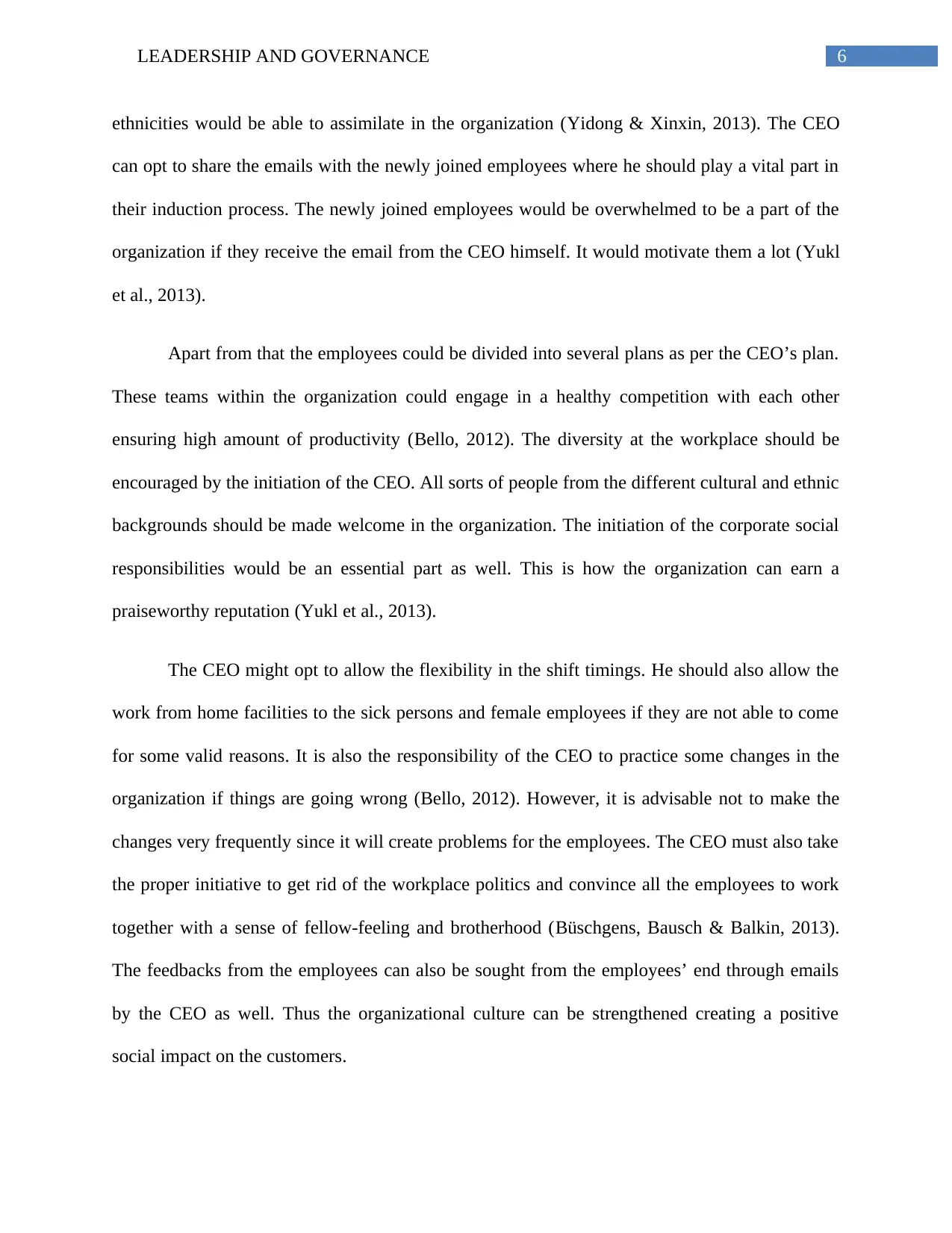
6LEADERSHIP AND GOVERNANCE
ethnicities would be able to assimilate in the organization (Yidong & Xinxin, 2013). The CEO
can opt to share the emails with the newly joined employees where he should play a vital part in
their induction process. The newly joined employees would be overwhelmed to be a part of the
organization if they receive the email from the CEO himself. It would motivate them a lot (Yukl
et al., 2013).
Apart from that the employees could be divided into several plans as per the CEO’s plan.
These teams within the organization could engage in a healthy competition with each other
ensuring high amount of productivity (Bello, 2012). The diversity at the workplace should be
encouraged by the initiation of the CEO. All sorts of people from the different cultural and ethnic
backgrounds should be made welcome in the organization. The initiation of the corporate social
responsibilities would be an essential part as well. This is how the organization can earn a
praiseworthy reputation (Yukl et al., 2013).
The CEO might opt to allow the flexibility in the shift timings. He should also allow the
work from home facilities to the sick persons and female employees if they are not able to come
for some valid reasons. It is also the responsibility of the CEO to practice some changes in the
organization if things are going wrong (Bello, 2012). However, it is advisable not to make the
changes very frequently since it will create problems for the employees. The CEO must also take
the proper initiative to get rid of the workplace politics and convince all the employees to work
together with a sense of fellow-feeling and brotherhood (Büschgens, Bausch & Balkin, 2013).
The feedbacks from the employees can also be sought from the employees’ end through emails
by the CEO as well. Thus the organizational culture can be strengthened creating a positive
social impact on the customers.
ethnicities would be able to assimilate in the organization (Yidong & Xinxin, 2013). The CEO
can opt to share the emails with the newly joined employees where he should play a vital part in
their induction process. The newly joined employees would be overwhelmed to be a part of the
organization if they receive the email from the CEO himself. It would motivate them a lot (Yukl
et al., 2013).
Apart from that the employees could be divided into several plans as per the CEO’s plan.
These teams within the organization could engage in a healthy competition with each other
ensuring high amount of productivity (Bello, 2012). The diversity at the workplace should be
encouraged by the initiation of the CEO. All sorts of people from the different cultural and ethnic
backgrounds should be made welcome in the organization. The initiation of the corporate social
responsibilities would be an essential part as well. This is how the organization can earn a
praiseworthy reputation (Yukl et al., 2013).
The CEO might opt to allow the flexibility in the shift timings. He should also allow the
work from home facilities to the sick persons and female employees if they are not able to come
for some valid reasons. It is also the responsibility of the CEO to practice some changes in the
organization if things are going wrong (Bello, 2012). However, it is advisable not to make the
changes very frequently since it will create problems for the employees. The CEO must also take
the proper initiative to get rid of the workplace politics and convince all the employees to work
together with a sense of fellow-feeling and brotherhood (Büschgens, Bausch & Balkin, 2013).
The feedbacks from the employees can also be sought from the employees’ end through emails
by the CEO as well. Thus the organizational culture can be strengthened creating a positive
social impact on the customers.
Paraphrase This Document
Need a fresh take? Get an instant paraphrase of this document with our AI Paraphraser
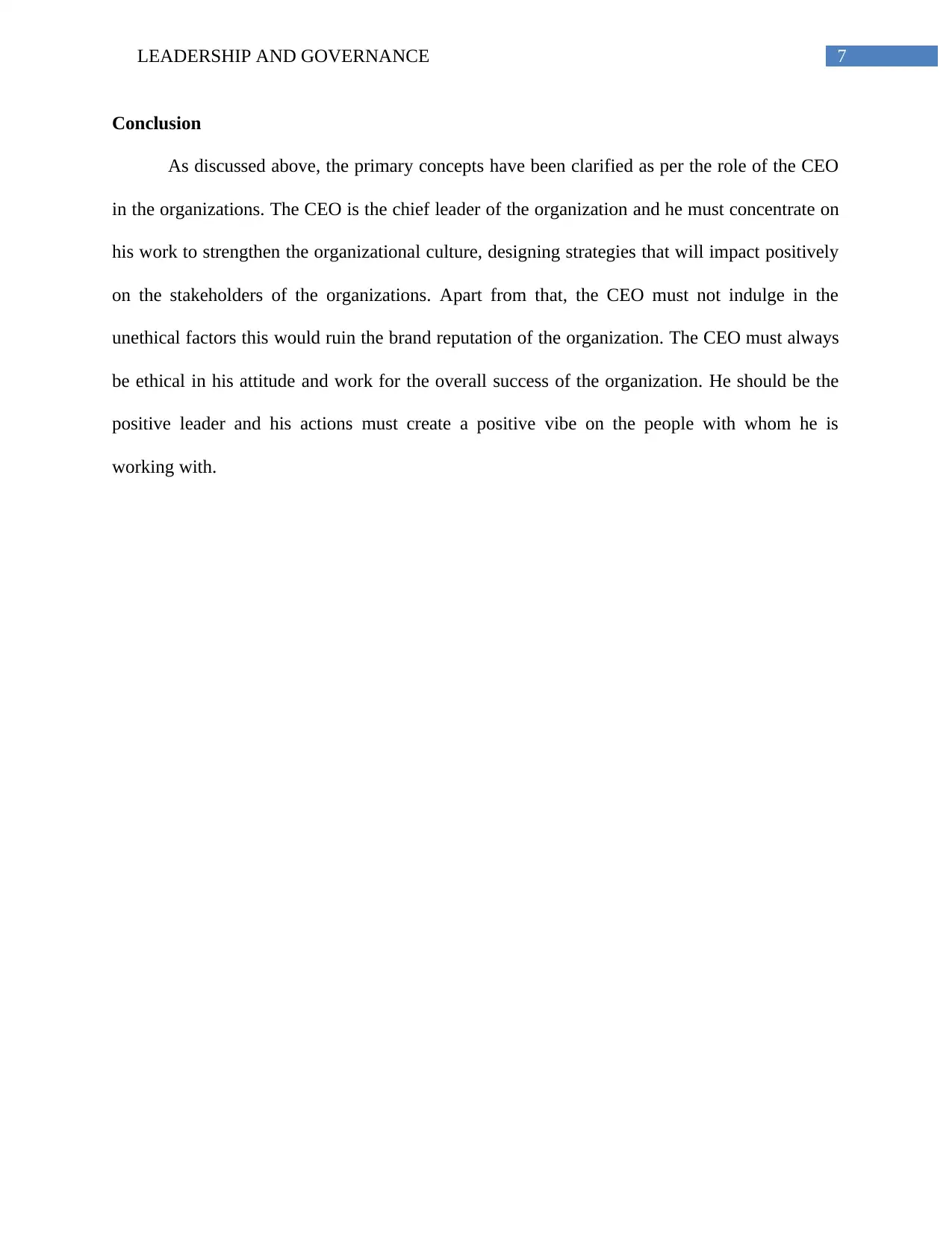
7LEADERSHIP AND GOVERNANCE
Conclusion
As discussed above, the primary concepts have been clarified as per the role of the CEO
in the organizations. The CEO is the chief leader of the organization and he must concentrate on
his work to strengthen the organizational culture, designing strategies that will impact positively
on the stakeholders of the organizations. Apart from that, the CEO must not indulge in the
unethical factors this would ruin the brand reputation of the organization. The CEO must always
be ethical in his attitude and work for the overall success of the organization. He should be the
positive leader and his actions must create a positive vibe on the people with whom he is
working with.
Conclusion
As discussed above, the primary concepts have been clarified as per the role of the CEO
in the organizations. The CEO is the chief leader of the organization and he must concentrate on
his work to strengthen the organizational culture, designing strategies that will impact positively
on the stakeholders of the organizations. Apart from that, the CEO must not indulge in the
unethical factors this would ruin the brand reputation of the organization. The CEO must always
be ethical in his attitude and work for the overall success of the organization. He should be the
positive leader and his actions must create a positive vibe on the people with whom he is
working with.
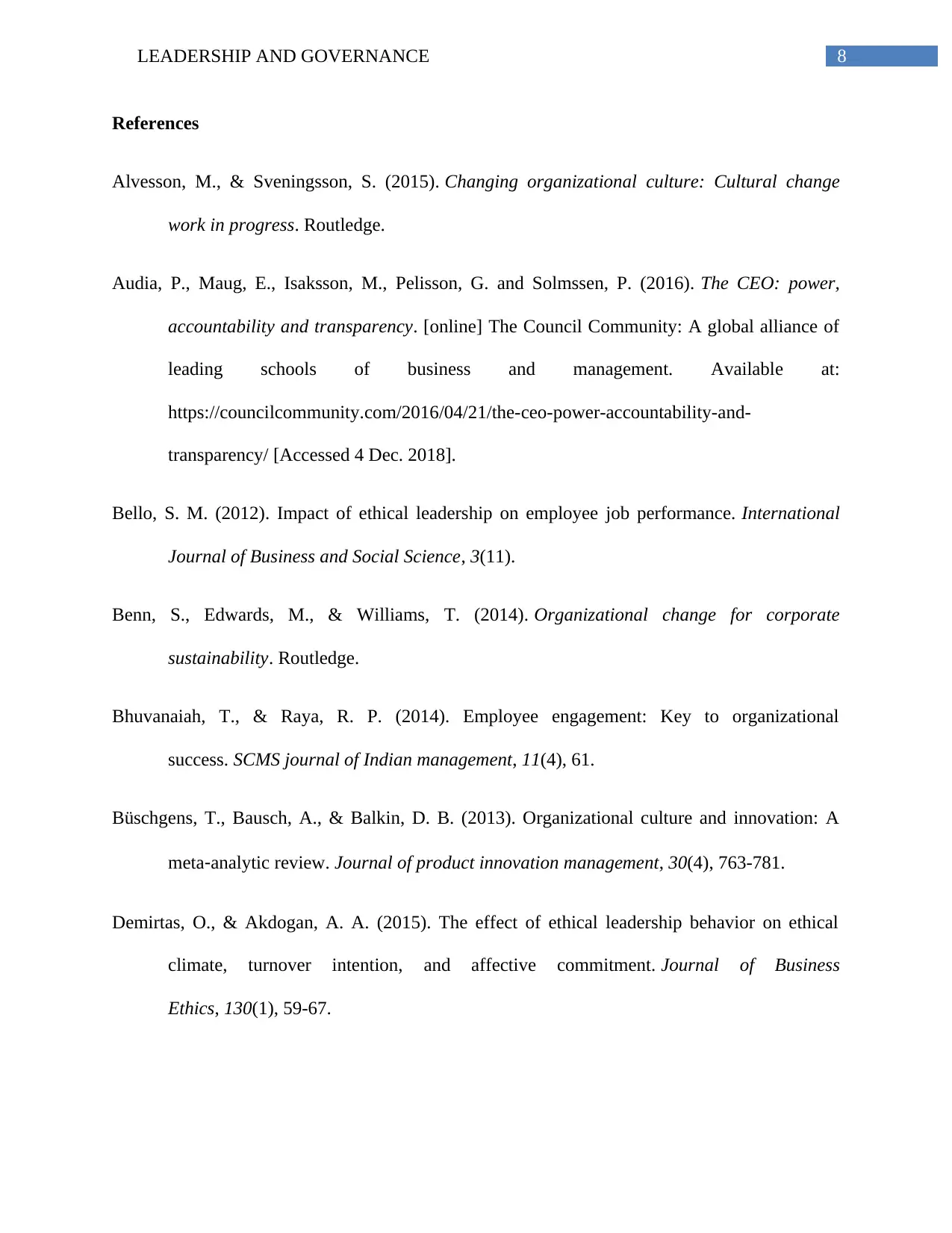
8LEADERSHIP AND GOVERNANCE
References
Alvesson, M., & Sveningsson, S. (2015). Changing organizational culture: Cultural change
work in progress. Routledge.
Audia, P., Maug, E., Isaksson, M., Pelisson, G. and Solmssen, P. (2016). The CEO: power,
accountability and transparency. [online] The Council Community: A global alliance of
leading schools of business and management. Available at:
https://councilcommunity.com/2016/04/21/the-ceo-power-accountability-and-
transparency/ [Accessed 4 Dec. 2018].
Bello, S. M. (2012). Impact of ethical leadership on employee job performance. International
Journal of Business and Social Science, 3(11).
Benn, S., Edwards, M., & Williams, T. (2014). Organizational change for corporate
sustainability. Routledge.
Bhuvanaiah, T., & Raya, R. P. (2014). Employee engagement: Key to organizational
success. SCMS journal of Indian management, 11(4), 61.
Büschgens, T., Bausch, A., & Balkin, D. B. (2013). Organizational culture and innovation: A
meta‐analytic review. Journal of product innovation management, 30(4), 763-781.
Demirtas, O., & Akdogan, A. A. (2015). The effect of ethical leadership behavior on ethical
climate, turnover intention, and affective commitment. Journal of Business
Ethics, 130(1), 59-67.
References
Alvesson, M., & Sveningsson, S. (2015). Changing organizational culture: Cultural change
work in progress. Routledge.
Audia, P., Maug, E., Isaksson, M., Pelisson, G. and Solmssen, P. (2016). The CEO: power,
accountability and transparency. [online] The Council Community: A global alliance of
leading schools of business and management. Available at:
https://councilcommunity.com/2016/04/21/the-ceo-power-accountability-and-
transparency/ [Accessed 4 Dec. 2018].
Bello, S. M. (2012). Impact of ethical leadership on employee job performance. International
Journal of Business and Social Science, 3(11).
Benn, S., Edwards, M., & Williams, T. (2014). Organizational change for corporate
sustainability. Routledge.
Bhuvanaiah, T., & Raya, R. P. (2014). Employee engagement: Key to organizational
success. SCMS journal of Indian management, 11(4), 61.
Büschgens, T., Bausch, A., & Balkin, D. B. (2013). Organizational culture and innovation: A
meta‐analytic review. Journal of product innovation management, 30(4), 763-781.
Demirtas, O., & Akdogan, A. A. (2015). The effect of ethical leadership behavior on ethical
climate, turnover intention, and affective commitment. Journal of Business
Ethics, 130(1), 59-67.
⊘ This is a preview!⊘
Do you want full access?
Subscribe today to unlock all pages.

Trusted by 1+ million students worldwide
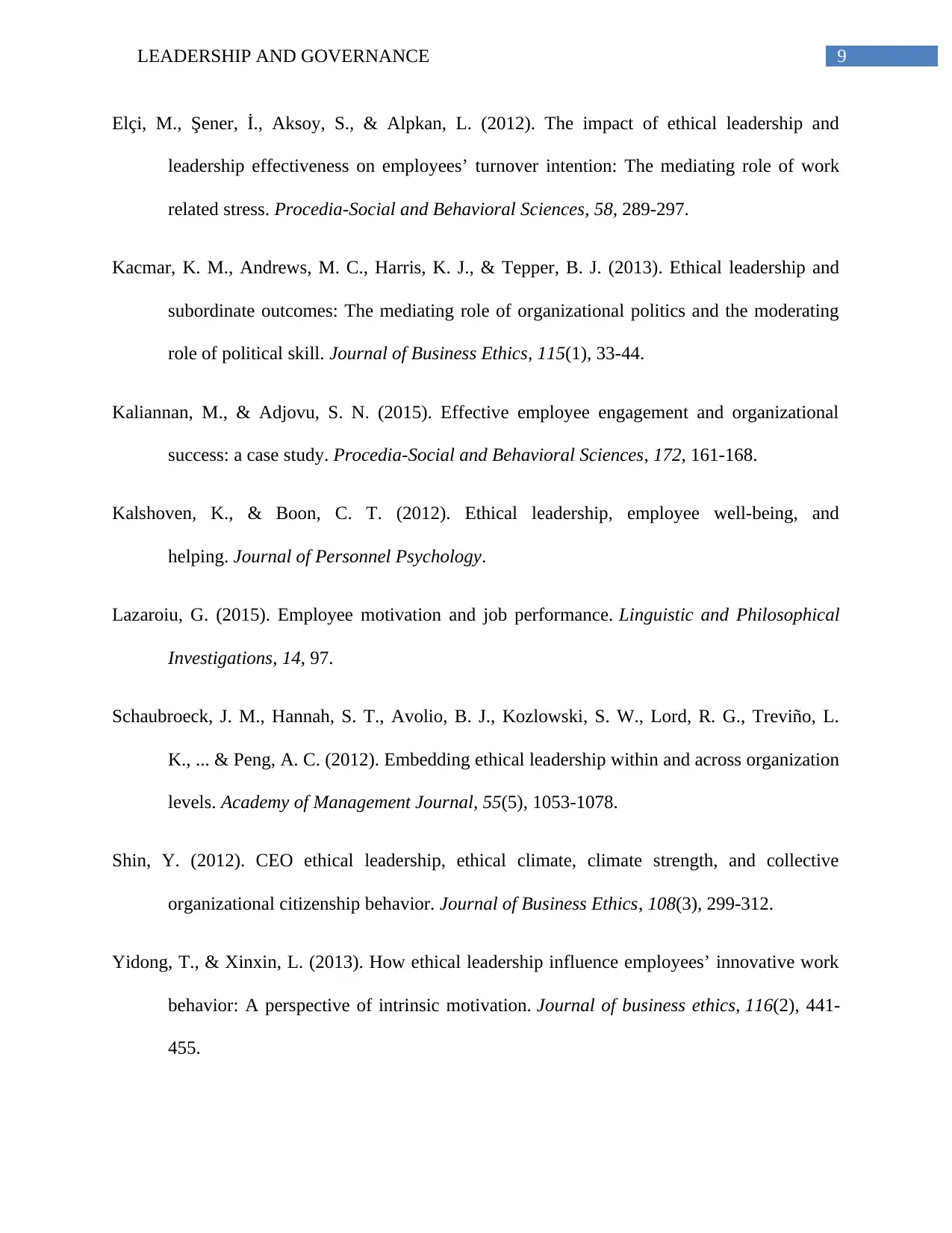
9LEADERSHIP AND GOVERNANCE
Elçi, M., Şener, İ., Aksoy, S., & Alpkan, L. (2012). The impact of ethical leadership and
leadership effectiveness on employees’ turnover intention: The mediating role of work
related stress. Procedia-Social and Behavioral Sciences, 58, 289-297.
Kacmar, K. M., Andrews, M. C., Harris, K. J., & Tepper, B. J. (2013). Ethical leadership and
subordinate outcomes: The mediating role of organizational politics and the moderating
role of political skill. Journal of Business Ethics, 115(1), 33-44.
Kaliannan, M., & Adjovu, S. N. (2015). Effective employee engagement and organizational
success: a case study. Procedia-Social and Behavioral Sciences, 172, 161-168.
Kalshoven, K., & Boon, C. T. (2012). Ethical leadership, employee well-being, and
helping. Journal of Personnel Psychology.
Lazaroiu, G. (2015). Employee motivation and job performance. Linguistic and Philosophical
Investigations, 14, 97.
Schaubroeck, J. M., Hannah, S. T., Avolio, B. J., Kozlowski, S. W., Lord, R. G., Treviño, L.
K., ... & Peng, A. C. (2012). Embedding ethical leadership within and across organization
levels. Academy of Management Journal, 55(5), 1053-1078.
Shin, Y. (2012). CEO ethical leadership, ethical climate, climate strength, and collective
organizational citizenship behavior. Journal of Business Ethics, 108(3), 299-312.
Yidong, T., & Xinxin, L. (2013). How ethical leadership influence employees’ innovative work
behavior: A perspective of intrinsic motivation. Journal of business ethics, 116(2), 441-
455.
Elçi, M., Şener, İ., Aksoy, S., & Alpkan, L. (2012). The impact of ethical leadership and
leadership effectiveness on employees’ turnover intention: The mediating role of work
related stress. Procedia-Social and Behavioral Sciences, 58, 289-297.
Kacmar, K. M., Andrews, M. C., Harris, K. J., & Tepper, B. J. (2013). Ethical leadership and
subordinate outcomes: The mediating role of organizational politics and the moderating
role of political skill. Journal of Business Ethics, 115(1), 33-44.
Kaliannan, M., & Adjovu, S. N. (2015). Effective employee engagement and organizational
success: a case study. Procedia-Social and Behavioral Sciences, 172, 161-168.
Kalshoven, K., & Boon, C. T. (2012). Ethical leadership, employee well-being, and
helping. Journal of Personnel Psychology.
Lazaroiu, G. (2015). Employee motivation and job performance. Linguistic and Philosophical
Investigations, 14, 97.
Schaubroeck, J. M., Hannah, S. T., Avolio, B. J., Kozlowski, S. W., Lord, R. G., Treviño, L.
K., ... & Peng, A. C. (2012). Embedding ethical leadership within and across organization
levels. Academy of Management Journal, 55(5), 1053-1078.
Shin, Y. (2012). CEO ethical leadership, ethical climate, climate strength, and collective
organizational citizenship behavior. Journal of Business Ethics, 108(3), 299-312.
Yidong, T., & Xinxin, L. (2013). How ethical leadership influence employees’ innovative work
behavior: A perspective of intrinsic motivation. Journal of business ethics, 116(2), 441-
455.
Paraphrase This Document
Need a fresh take? Get an instant paraphrase of this document with our AI Paraphraser
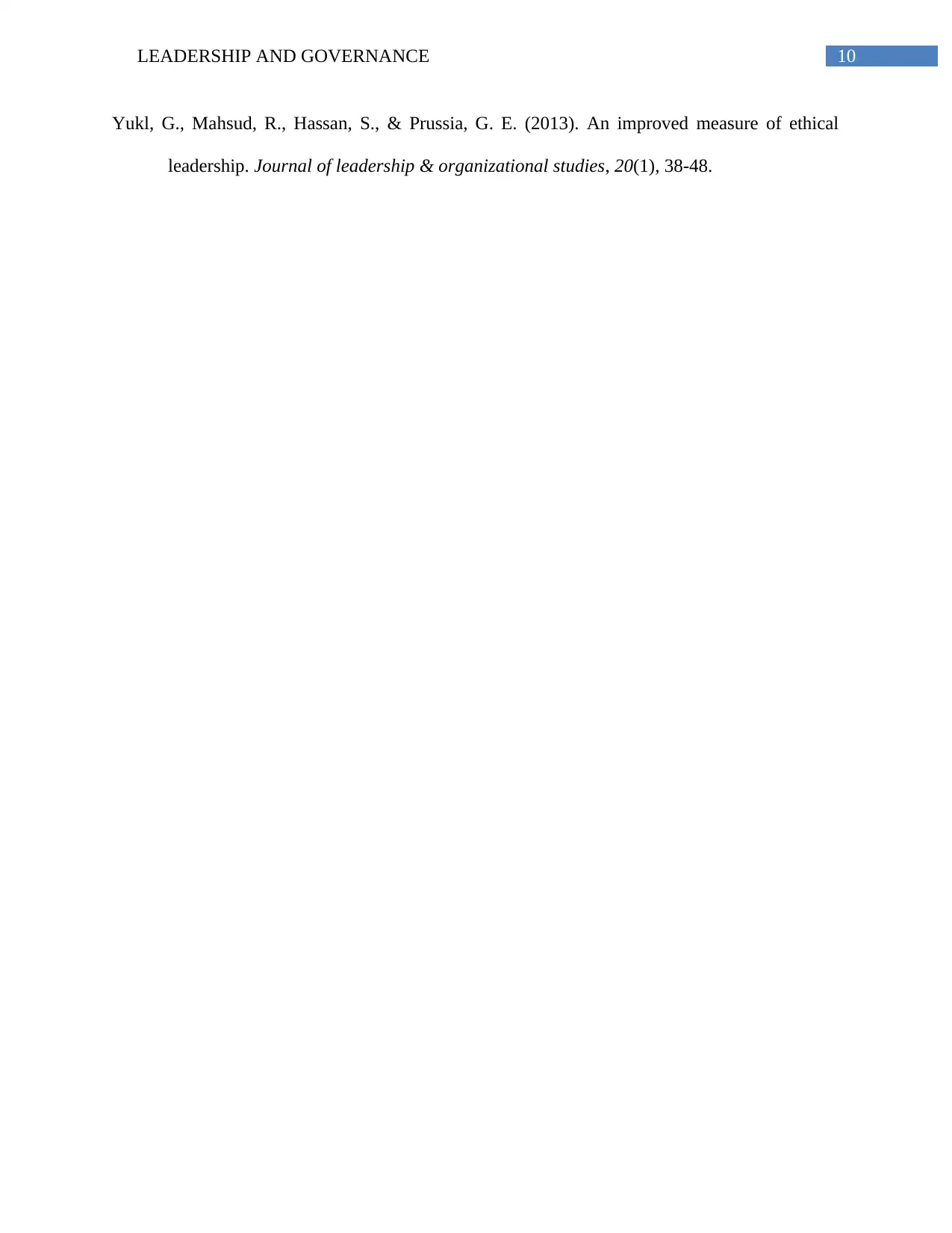
10LEADERSHIP AND GOVERNANCE
Yukl, G., Mahsud, R., Hassan, S., & Prussia, G. E. (2013). An improved measure of ethical
leadership. Journal of leadership & organizational studies, 20(1), 38-48.
Yukl, G., Mahsud, R., Hassan, S., & Prussia, G. E. (2013). An improved measure of ethical
leadership. Journal of leadership & organizational studies, 20(1), 38-48.
1 out of 11
Related Documents
Your All-in-One AI-Powered Toolkit for Academic Success.
+13062052269
info@desklib.com
Available 24*7 on WhatsApp / Email
![[object Object]](/_next/static/media/star-bottom.7253800d.svg)
Unlock your academic potential
© 2024 | Zucol Services PVT LTD | All rights reserved.





